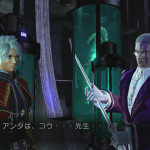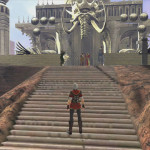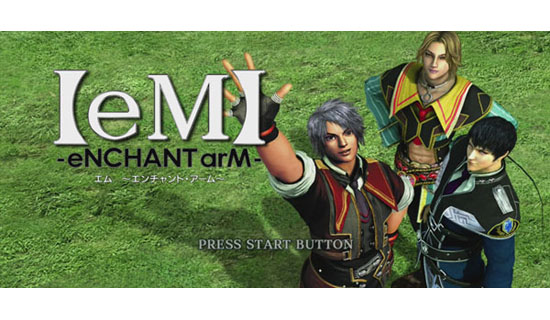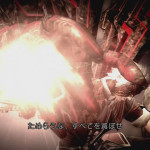From Software is a much more versatile developer than many give them credit for these days. So many of their flagship series have been oriented toward the “hardcore”: Kings Field, the Souls games and Armored Core. They’re also well versed in horror games with the Echo Night series and Kuon, and have even done straight up actions game like Otogi and Metal Wolf Chaos. What many people forget is that they have also made attempts at RPGs. While the Souls and Kings Field series are RPGs in a way, that isn’t exactly what I mean. From’s next RPG after the first three Kings Field games was Shadow Tower, which was a somewhat nontraditional take on the dungeon crawler that would receive a Playstation 2 sequel many years later. Then came Eternal Ring and Evergrace, which will serve as the introduction to Enchanted Arms.
Eternal Ring was released in Japan on March 4th 2000, and Evergrace on April 27th 2000, approximately 2 and 4 months after the system itself launched respectively. In North America, both were launch titles. While the games themselves were two completely different styles of RPGs, they were both somewhat traditional in the types of RPGs that they were, and they were both available at or near launch. They share in the fairly heavy criticism that they received all around as well. No one is going to say that either of these are anywhere close to their favorite RPGs, not even if you narrow things to Playstation 2 titles. In other words, From Software didn’t prove themselves to be very apt at making more traditional RPGs from the very beginning.
Fast forward to Enchanted Arms, released as the XBox 360’s first Japanese developed RPG, released approximately 1 month after the system itself launched in Japan. And keeping up with their last console generation record of having a launch-window RPG, it’s by From Software. My short assessment of Enchanted Arms is that it also keeps with From’s record of their more traditional RPGs being incredibly middling. In the scope of the RPGs created during the XBox 360/PS3/Wii generation, it probably does not sit near anyone’s top choices. Like Eternal Ring and Evergrace, it probably sold more than it ordinarily would have because it was an extremely early RPG on its respective console, serving to feed the masses of RPG hungry gamers who would consume it ravenously because they had little else to set their sights on at the time. That being said, this doesn’t mean that there is nothing interesting about the game at all.
Let’s get one thing out of the way first though, the plot is not one of those interesting things. Every inch of it is predictable, and it moves at what feels like a snail’s pace. Do not come into this game expecting the story of Atsuma, an enchanter from Yokohama City and his fairly stereotypical friends that he meets along the way in his quest to save a friend and defeat the Queen of Ice, to change your life. In fact don’t even expect it to really stick in your memory at all after you’re done. The character dialogue itself can at times be well written though, and the Japanese voice cast really serves to bring that to life. In fact, the voice cast is probably this game’s high point. Kishio Daisuke voices Atsuma, perhaps best known for his roles in Digimon (Zenjirou Tsurugi), Fairy Tail (Loki), Happy Lesson (Chitose Hitotose), Rosario + Vampire (Tsukune Aono), Vampire Knight (Kaname Clan), Yowamushi Peddle (Junta Teshima) and many others. Ueda Kana voices Karin, perhaps best known for her roles in the Fate series (Rin Tohsaka), Hayate the Combat Butler (Sakuya Aizawa) and many others. Even the game’s main villain, The Queen of Ice, is voiced by Watanabe Misa who I know best as Vivi Nefertari from One Piece. She certainly demonstrates that she can do a range of characters, comparing her performance in this game with her work in One Piece. There is also a strange fascination with the dialogue pattern of “(something) of (something)”. We have such actual lines of dialogue as “God of Atsuma” and “King of baka yarou” (“King of Idiots”). Also villains such as the previously mentioned “Queen of Ice” and my personal favorite, “Brain of Head”. As for how the player interacts with the world itself, there is no “world map”, but rather the player is walking through an interconnected series of areas.
While no other aspect of Enchanted Arms says “strategy RPG”, the battle system is a bit like a light version of one. The entire battle field is grid based (though it is a much smaller grid than what you would find in any strategy RPG) and each individual skill has a set range that it effects. For those who have never played one but are interested in learning how they work, Enchanted Arms’ battle system could actually serve as a very rudimentary introduction to a strategy RPG. A primitive elemental weakness system is also at play here, with fire/water, wind/earth and light/dark opposing one another directly. While each character gains experience points and levels in the traditional way, skill points are also earned after each battle. Each character’s skill points can be used to additionally increase their individual stats in a selection of different areas: Hit Points, Ether Points (the points consumed when a skill is used), Direct Damage, Distance Damage, Support and Speed. To round out the various types of points earned, there are also TB, which stands for Tablets. These are used to purchase items, skills, weapons and golem cores (more on that in a moment) from shops.
 |  |
| Enchanted Arms’ grid-based battle system, sort of like a light strategy RPG battle system. | Who would have thought that the horribly disfigured teacher is actually a villain?! |
As the story progresses you will eventually have the option of filling out your party with 4 human characters. Until that time though (and at various story points when a character is missing), Enchanted Arms gives you an answer to filling in those holes in your party with golems. Golems can be fused from cores, which can either be created with materials or obtained from fighting golems that sometimes appear in various locations. They can be leveled up and have their individual parameters raised just like a human character, though they can not learn additional skills from those that they came with. There are a rather large number of golems that can be found throughout the game for those that have a “gotta catch ’em all” mentality. While their use is not required to do well, some golems have skills that a human character can never learn (including those that correspond to the light and dark elements mentioned earlier) and can be extremely powerful. Keeping multiple golems leveled up without regular use is made easier by the fact that you can have up to eight of them in a sort of storage that allows them to gain experience points outside of battles, though not skill points.
One of the most surprising things about Enchanted Arms is how nice it is to the player for a From Software game. Even the most rudimentary of concepts are overly explained in the guise of Atsuma being dimwitted, down to such simple ones as “Press A to use this magic device to cross a gap”. All characters HP and EP are completely regenerated after each battle, making rejuvenating those something only to be worried about in battle. There are Vitality Points that gradually degenerate with each battle, but those can be completely replenished at one of the many restoration points found throughout the different areas, or by specific items. While some of the battles can be challenging, as long as you are properly leveled, understand which elements are weak against each other, and utilize each characters skills properly, there aren’t many that will give too much trouble. Experience points for leveling do seem to come a little slowly though, given the time period in which this game was made.
 |  |
| You know you’ve made it when you can decorate the front of your mansion with elephant heads. | Kyoto City, based off of Kyoto. Who knew?! |
Though this game is on the subsequent console generation, it’s fairly clear that From Software’s art asset design was still coming from a Playstation 2 mindset. Particularly when it comes to the character models. They get a slight boost out of the more modern hardware, and certainly some of the effects and background quality would not have been possible to this degree on any lesser hardware. There is also some very strange, stilted attempt at realistic motion of clothing on the character models during the dialogue sequences as well. It made the character models in those scenes look as though their clothing and hair were all made out of rubber. The actual cut scenes look considerably better though. In general don’t go expecting a Final Fantasy 13 level of graphics here, but to that I would also point out that this is a launch-window RPG and very much represents a developer getting their arms around developing for a new generation of consoles. In fact that is really the summary of this game in general: It sure is a middling, launch-window RPG. One of Enchanted Arms’ claims to fame might have been that it was an XBox 360 exclusive, but approximately one year later a version of it was released for the Playstation 3 as well. This will perhaps at some point be covered in a separate article, as it had some significant changes made to it. The XBox 360 version does boast an online multi-player mode that remains exclusive to it though, allowing you to choose a party and battle against another player (though I’m sure you will find none still playing at this point).
Is it worth playing now? With all of the fantastic RPGs available during this console generation, it’s very hard to recommend it to anyone but those who haven’t already played everything else. Is it worth playing if you only own an XBox 360? Certainly more so if that’s the case, but even then you still have arguably better games like Blue Dragon and Lost Odyssey to look to. Was it worth playing if you had an XBox 360 at launch and liked JRPGs? It absolutely was, proving that it was just as much of a product of its time as most of From Software’s other attempts at traditional RPGs.


